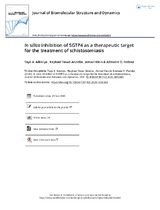| dc.description | Schistosomiasis is an infectious tropical disease caused by parasitic flatworm of the genus Schistosoma. This debilitating disease chronically infects about 200 million people globally and management relies on chemotherapy. Unfortunately, the solely available schistosomicide (praziquantel) against all forms of adult schistosmes has been faced with numerous drawbacks. Thus, there is an urgent need to design and develop a new regimen for schistosomiasis. In light of this, the current study focuses on inhibiting the schistosome glucose transporter 4 (SGTP4) as a therapeutic candidate for schistosomiasis. Several studies have revealed that Schistosoma parasites require an adequate amount of energy/glucose to survive. We modelled the 3D structure and subsequently used the homology model for docking with praziquantel (PZQ), Licochalcone A, Licarin and Harmonine. The docked complexes were subjected to molecular dynamics using Desmond system of Schrodinger software. Furthermore, the pharmacokinetic parameters of the ligands were investigated using the QikProp tool in the Schrodinger-2019-4 software suite. After performing all the computational analysis, our findings reveal that all four ligands were able to inhibit SGTP4 effectively through the higher glide G score (dock score) of −5.8 (−5.8), −6.5 (−6.4), −7.3 (−7.3) and −4.9 (−4.9) in kcal/mol for praziquantel, licochalcone A, licarin and harmonine respectively against the protein. The molecular simulation further confirmed that thestability of the complexes formed between the ligands and protein is excellent. More so, all the ligands fulfilled oral drugability of both the Lipinski’s rule of five and Veber’s rules. The findings in this present study provide new useful insights for the design of drugs which can serve as an alternative to praziquantel in the treatment of schistosomiasis through the inhibition of SGTP4. Communicated by Freddie R. Salsbury | en_US |

